LONDON, ENGLAND – A likely record Brazilian crop, with Argentina’s production problems already factored in, and subdued demand were at the top of the list of factors behind easing oilseeds prices in recent weeks.
The International Grains Council (IGC), in its Grain Market Report of March 16, said that its subindex for soybean prices had fallen by around 3% over the preceding month, “stemming from softer quotations at all origins.”
There were a number of competing factors behind a net 2% month-on-month fall in Chicago spot futures, the IGC said.
“Although expectations for a steep fall in (soybean) production in Argentina were initially supportive, this was countered by pressure from threshing of what is set to be a record Brazilian crop,” the report said. “Adding to bearish sentiment was seasonally slower international demand for US supplies, as well as weaker markets for soya products. More recently, renewed economic and financial market worries were a negative influence.”
The IGC put US Gulf export values at $586 fob, down 2% on the month.
A month-on-month fall of nearly 5%, to $535 fob, in Brazilian export quotations (Paranagua) was “chiefly linked to the progressing harvest and an uptick in grower sales,” the IGC said. “While Up River fob prices in Argentina were also a touch lower, offers were termed nominal amid dwindling crop prospects and thin farmer sales.”
“The main reasons for pressure across the week was from the ongoing Brazilian harvest and much of Argentina’s soybean drought damage already being priced in the week before." - AHDB
For rapeseed the IGC reported that Canadian ICE canola futures were down by 9% month-on-month “as subdued offshore demand and technical selling weighed, while fob values (Vancouver) fell, by $65, to $599.”
The IGC noted that in Australia ample supplies also pressured prices, with fob Kwinana values down by $98 to $637.
Reporting on the oilseeds market on March 13, the British Agricultural and Horticultural Development Board (AHDB) explained that there had been a “week of pressure” in oilseeds the previous week, with Chicago May 2023 futures down about 1%.
“The main reasons for pressure across the week was from the ongoing Brazilian harvest and much of Argentina’s soybean drought damage already being priced in the week before (from the week commencing Feb. 27),” AHDB said. “The Brazilian soybean harvest is now estimated at 48.9% complete, but this is back from 60.5% at the same point last year.”
AHDB added, “we are approaching the point where origin will switch from US to South American for global demand.”
At the same time, AHDB noted “widespread pressure in rapeseed markets across the week,” with falls in the Paris futures as well as in delivered prices in England.
“ICE Canadian canola futures were down 6% from heavy selling by speculative funds,” AHDB said. The British organization added that Australia’s ABARES (the Australian Bureau of Agricultural and Resource Economics and Sciences) had announced in early March that Australia’s canola crop for 2022-23 was now estimated at 8.3 million tonnes, up 1 million tonnes from the last estimate, with the La Niña weather event leading to record yields.
In its Food Price Index report, published on March 3, the United Nations Food and Agriculture Organization (FAO) said vegetable oil prices were down by 3.2% in February compared with January, reaching their lowest level since the start of 2021.
“The continued weakness of the index was driven by lower world prices across palm, soy, sunflowerseed and rapeseed oils,” the FAO said. “International palm oil prices dropped for the third consecutive month in February, chiefly weighed by lingering sluggish global import demand, despite seasonally lower production from major growing regions in Southeast Asia.”






